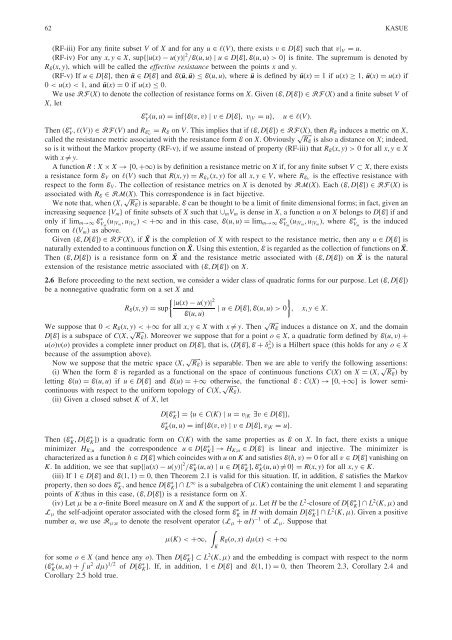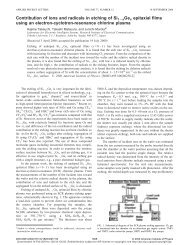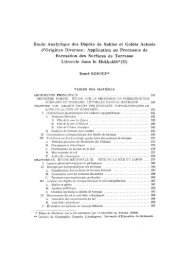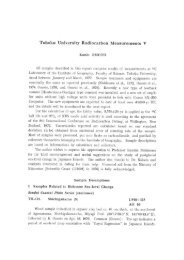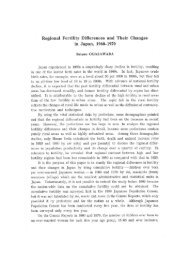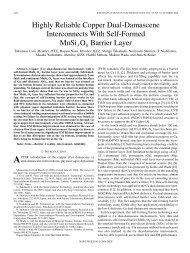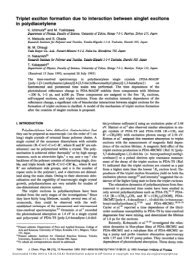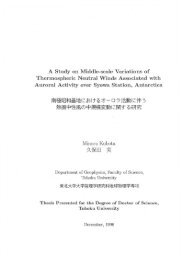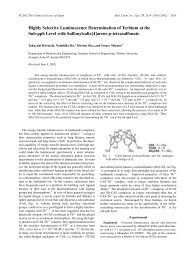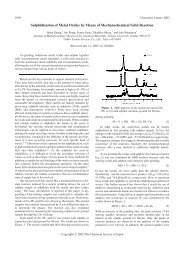Variational Convergence of Finite Networks
Variational Convergence of Finite Networks
Variational Convergence of Finite Networks
Create successful ePaper yourself
Turn your PDF publications into a flip-book with our unique Google optimized e-Paper software.
62 KASUE<br />
(RF-iii) For any finite subset V <strong>of</strong> X and for any u 2 ‘ðVÞ, there exists v 2 D½EŠ such that vjV ¼ u.<br />
(RF-iv) For any x; y 2 X, supfjuðxÞ uðyÞj2 =Eðu; uÞ ju 2 D½EŠ; Eðu; uÞ > 0g is finite. The supremum is denoted by<br />
REðx; yÞ, which will be called the effective resistance between the points x and y.<br />
(RF-v) If u 2 D½EŠ, then u 2 D½EŠ and Eðu; uÞ Eðu; uÞ, where u is defined by uðxÞ ¼1 if uðxÞ 1, uðxÞ ¼uðxÞ if<br />
0 < uðxÞ < 1, and uðxÞ ¼0 if uðxÞ 0.<br />
We use RF ðXÞ to denote the collection <strong>of</strong> resistance forms on X. Given ðE; D½EŠÞ 2 RF ðXÞ and a finite subset V <strong>of</strong><br />
X, let<br />
EVðu; uÞ ¼inffEðv; vÞ jv 2 D½EŠ; vjV ¼ ug; u 2 ‘ðVÞ:<br />
Then ðEV ;‘ðVÞÞ 2 RF ðVÞ and RE ¼ RE on V. This implies that if ðE; D½EŠÞ 2 RF ðXÞ, then RE induces a metric on X,<br />
V pffiffiffiffiffi called the resistance metric associated with the resistance form E on X. Obviously RE is also a distance on X; indeed,<br />
so is it without the Markov property (RF-v), if we assume instead <strong>of</strong> property (RF-iii) that REðx; yÞ > 0 for all x; y 2 X<br />
with x 6¼ y.<br />
A function R : X X !½0; þ1Þ is by definition a resistance metric on X if, for any finite subset V X, there exists<br />
a resistance form EV on ‘ðVÞ such that Rðx; yÞ ¼REV ðx; yÞ for all x; y 2 V, where REV is the effective resistance with<br />
respect to the form EV. The collection <strong>of</strong> resistance metrics on X is denoted by RMðXÞ. Each ðE; D½EŠÞ 2 RF ðXÞ is<br />
associated with RE 2 RMðXÞ.<br />
pffiffiffiffiffi This correspondence is in fact bijective.<br />
We note that, when ðX; REÞ<br />
is separable, E can be thought to be a limit <strong>of</strong> finite dimensional forms; in fact, given an<br />
increasing sequence fVmg <strong>of</strong> finite subsets <strong>of</strong> X such that [mVm is dense in X, a function u on X belongs to D½EŠ if and<br />
only if limm!1 EVmðujVm ; ujVmÞ < þ1 and in this case, Eðu; uÞ ¼limm!1 EVmðujVm ; ujVmÞ, where E is the induced<br />
Vm<br />
form on ‘ðVmÞ as above.<br />
Given ðE; D½EŠÞ 2 RF ðXÞ, ifX is the completion <strong>of</strong> X with respect to the resistance metric, then any u 2 D½EŠ is<br />
naturally extended to a continuous function on X. Using this extention, E is regarded as the collection <strong>of</strong> functions on X.<br />
Then ðE; D½EŠÞ is a resistance form on X and the resistance metric associated with ðE; D½EŠÞ on X is the natural<br />
extension <strong>of</strong> the resistance metric associated with ðE; D½EŠÞ on X.<br />
2.6 Before proceeding to the next section, we consider a wider class <strong>of</strong> quadratic forms for our purpose. Let ðE; D½EŠÞ<br />
be a nonnegative quadratic form on a set X and<br />
juðxÞ uðyÞj2<br />
REðx; yÞ ¼sup j u 2 D½EŠ; Eðu; uÞ > 0 ; x; y 2 X:<br />
Eðu; uÞ<br />
pffiffiffiffiffi We suppose that 0 < REðx; yÞ < þ1 for all x; y 2 X with x 6¼ y. Then RE<br />
pffiffiffiffiffi induces a distance on X, and the domain<br />
D½EŠ is a subspace <strong>of</strong> CðX; REÞ.<br />
Moreover we suppose that for a point o 2 X, a quadratic form defined by Eðu; vÞþ<br />
uðoÞvðoÞ provides a complete inner product on D½EŠ, that is, ðD½EŠ; E þ 2 oÞ is a Hilbert space (this holds for any o 2 X<br />
because <strong>of</strong> the assumption above).<br />
pffiffiffiffiffi Now we suppose that the metric space ðX; REÞ<br />
is separable. Then we are able to verify the following assertions:<br />
pffiffiffiffiffi (i) When the form E is regarded as a functional on the space <strong>of</strong> continuous functions CðXÞ on X ¼ðX; REÞ<br />
by<br />
letting EðuÞ ¼Eðu; uÞ if u 2 D½EŠ and EðuÞ ¼þ1otherwise, pffiffiffiffiffi the functional E : CðXÞ !½0; þ1Š is lower semicontinuous<br />
with respect to the uniform topology <strong>of</strong> CðX; REÞ.<br />
(ii) Given a closed subset K <strong>of</strong> X, let<br />
D½EKŠ¼fu 2 CðKÞ ju ¼ vjK 9v 2 D½EŠg;<br />
EKðu; uÞ ¼inffEðv; vÞ jv 2 D½EŠ; vjK ¼ ug:<br />
Then ðEK ; D½EKŠÞ is a quadratic form on CðKÞ with the same properties as E on X. In fact, there exists a unique<br />
minimizer HK;u and the correspondence u 2 D½EKŠ!HK;u 2 D½EŠ is linear and injective. The minimizer is<br />
characterized as a function h 2 D½EŠ which coincides with u on K and satisfies Eðh; vÞ ¼0 for all v 2 D½EŠ vanishing on<br />
K. In addition, we see that supfjuðxÞ uðyÞj2 =EKðu; uÞ ju 2 D½EKŠ; EKðu; uÞ 6¼ 0g ¼Rðx; yÞ for all x; y 2 K.<br />
(iii) If 1 2 D½EŠ and Eð1; 1Þ ¼0, then Theorem 2.1 is valid for this situation. If, in addition, E satisfies the Markov<br />
property, then so does EK , and hence D½EKŠ\L1 is a subalgebra <strong>of</strong> CðKÞ containing the unit elememt 1 and separating<br />
points <strong>of</strong> K;thus in this case, ðE; D½EŠÞ is a resistance form on X.<br />
(iv) Let be a -finite Borel measure on X and K the support <strong>of</strong> . Let H be the L2-closure <strong>of</strong> D½EKŠ\L2ðK; Þ and<br />
L the self-adjoint operator associated with the closed form EK in H with domain D½EKŠ\L2ðK; Þ. Given a positive<br />
number , we use R ; to denote the resolvent operator ðL þ IÞ 1 <strong>of</strong> L . Suppose that<br />
Z<br />
ðKÞ < þ1; REðo; xÞ d ðxÞ < þ1<br />
K<br />
for some o 2 X (and hence any o). Then D½E K Š L 2 ðK; Þ and the embedding is compact with respect to the norm<br />
ðE K ðu; uÞþ R u 2 d Þ 1=2 <strong>of</strong> D½E K Š. If, in addition, 1 2 D½EŠ and Eð1; 1Þ ¼0, then Theorem 2.3, Corollary 2.4 and<br />
Corollary 2.5 hold true.


